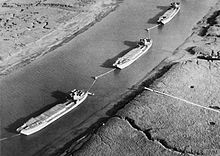Operation Fortitude
Fortitude had evolved from plans submitted by Noel Wild, the head of Ops (B), and John Bevan, from the London Controlling Section in late 1943.Early revisions in January 1944 suggested a fictional buildup of troops in southern England with the hope of drawing German attention to the Calais region.The operation was intended to divert Axis attention away from Normandy and, after the invasion on 6 June 1944, to delay reinforcement by convincing the Germans that the landings had been purely a diversionary attack.Bodyguard's main objectives were to ensure that the Germans would not increase troop presence in Normandy and to do so by promoting the appearance that the Allies would attack in other locations.Montgomery, commanding the Allied landing forces, knew that the crucial aspect of any invasion was the ability to enlarge a beachhead into a full front.That meant that any deception would have to convince the German high command that the Allies were not committing their full forces into Normandy, but holding many of those formations in reserve.[2] Planning for Bodyguard overall came under the auspices of the London Controlling Section (LCS), a secret body that was set up to manage Allied deception strategy during the war.[note 1][3] The idea of creating fake formations as a method of deception had been pioneered in Cairo by Dudley Clarke's 'A' Force earlier in the war.Wild's first version of the Fortitude plan was socialised in early January 1943 with SHAEF, political leaders and the staff officers of the 21st Army Group.[7] On 25 January, Montgomery's Chief of Staff, Francis de Guingand, sent a letter to the deception planners that asked them to focus on Pas-de-Calais as the main assault and was almost certainly sent at the behest of Strangeways.In the revised plan, which was issued on 30 January and approved by the Allied chiefs on 18 February, fifty divisions would be positioned in Southern England to attack Pas de Calais.[13] Strangeways's final concerns related to the effort required for physical deception, as the plan called for large numbers of troop movements and dummy craft.[14][15] Finally, in a 23 February meeting between R Force and Ops (B), Strangeways tore up a copy of the plan, declared it useless, and announced that he would rewrite it from scratch.[10] Strangeways's revised Fortitude plan and an operational implementation, dubbed Quicksilver, invented an entire new field army but crucially without significant fictional forces.[16] To add credence to the importance of FUSAG, Bradley was replaced by Lieutenant General George Patton, whom the Germans held in high regard and who was known to be a competitor to Montgomery.[18] Pas-de-Calais offered a number of advantages over the real invasion site, such as by being the shortest crossing of the English Channel and the quickest route into Germany.[31] Skye was split into four sections, relating to different divisions of the Fourth Army[note 4] On 20 July, Ops (B) took over control of Fortitude South from R Force.As a result, elements of FUSAG had been detached and sent to reinforce Normandy, and a second smaller Second American Army Group (SUSAG) would be formed to threaten the Pas-de-Calais.[36] Through the evolved plan, the Allies maintained the pretense of FUSAG and other forces threatening Pas-de-Calais for some considerable time after D-Day, possibly even as late as September 1944.On 1 June, a decrypted transmission by Hiroshi Ōshima, the Japanese ambassador, to his government recounted a recent conversation with Hitler and confirmed the effectiveness of Fortitude.In an appreciation of 8 May von Rundstedt said:[39] Observed tonnage of landing shipping could be taken as sufficient for 12 or 13 divisions (less heavy equipment and rear elements) for fairly short sea routes.



Operation BodyguardBodyguardMilitary deceptionLondon Controlling SectionOps (B)R ForceAxis powersOperation OverlordAtlantic WallZeppelinTitanicTaxable, Glimmer & Big DrumCombined Bomber OffensivePointblankTransport PlanPostage AbleTarbrushFabiusCaen canal and Orne river bridgesMerville BatteryMallardAmerican SectorAlbanyBostonChicagoDetroitElmiraNormandy landingsPointe du HocGambitPort-en-BessinAmericanOperation ChastityBritishMulberryBrécourt ManorGraignesLa Haye-du-PuitsSaint-LôCarentanHill 30CherbourgBrévilleVillers-BocageLe Mesnil-PatryNormandy massacresArdenne AbbeyDouvresMartletWindsorCharnwoodJupiter2nd OdonAtlanticGoodwoodVerrières RidgeSpringBluecoatTotalizeHill 140LüttichTractableHill 262ChamboisFalaiseSaint-MaloMantes-GassicourtLa RochelleUshantLa CainePierres NoiresAudierne BayJedburghDingsonSamwestCooneyBulbasketHoundsworthLoytonKiplingDragoonWallace & HardyCemeteriesGerman High CommandNoel WildJohn BevanCalaisDavid Strangewaysfield armiesEdinburghFortitude NorthPas de CalaisFortitude SouthOberkommando der Wehrmachtoccupied NorwaytheatreSupreme Headquarters Allied Expeditionary ForceDwight D. Eisenhower21st Army GroupBernard MontgomeryDudley Clarke'A' ForceDouble Cross SystemJuan Pujol GarcíaIron CrossRoman CzerniawskiDušan PopovFrancis de GuingandWinston ChurchillFirst United States Army GroupOmar BradleyGeorge PattonPas-de-CalaisOperation NeptuneEnglish ChannelErwin Rommelorder of battleEdinburgh CastleFourth ArmyNorwayOperation TindallMutt and JeffMoray FirthThird United States ArmyLesley J. McNairJohn L. DeWitt